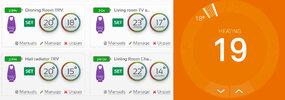Always have the room where the stat is located on full otherwise they can fight against reach other, usually ending up with the boiler cycling and therefore wasting energy.
I must question that, purely down to mothers house, I stuck with no TRV in the hall and struggled to get the heating to work as required, then I decided to take bull by the horns and fit a TRV in the hall, same room as the wall thermostat.
The transformation was huge, opened up the lock shield a little so radiator could heat up a little faster, but what you need to remember is a mechanical TRV has an operating temperature range of 2ºC or more, where the wall thermostat is likely only 0.5ºC between on and off, not used a modulating thermostat so can't say how they work.
So the scenario, front door opened, hall cools down, in her wheel chair it would likely take me 5 minutes to get her in/out of the house, but same applies when unloading a car. So the TRV and wall thermostat turn on, but before the wall thermostat opens, the TRV starts to close, so hall heats up fast from 10ºC to 17ºC, but then it slows down as the TRV starts to close, this stops the boiler switching off prematurely, and allows it to heat rest of house, and in the heart of winter boiler will never switch off.
So jump to how the boiler works, each manufacturer has a different algorithm, so it will vary, but whole idea is the boiler measures the temperature of the return water, and the hotter the return water is, the more the boiler modulates, (turns down) so as each TRV starts to close, first the water is diverted to radiators where the TRV is still open, and then it will start to lift the by-pass valve, so hot water is returned to boiler so boiler turns down more.
Until that is the boiler reaches minimum output, now the only way to reduce the output further is to use a mark/space ratio, and slowly the mark time decreases, and the space time increases, but the important thing is when the boiler restarts, it does so at minimum output, so most economic point, however there is a problem with this, it can never turn the boiler off fully, as unless the water is circulated the boiler can't know when no longer needed.
So some where we need a wall on/off thermostat so when summer arrives, the boiler will switch fully off, also we tend to want the home cooled at some parts of the day to others, so if we want the boiler to only heat home to 17ºC at night, 19ºC during the day, and 21ºC in the evening, the wall thermostat and TRV need to both change.
Also the TRV is often mounted lower than the wall thermostat, so in winter my TRV is reporting 16ºC (just read it) and the wall thermostat 17.5ºC (again just read it) on a cold day there is more of a difference, at moment 15.9ºC outside.
So to have different temperatures through the day, both the TRV and the wall thermostat need to be programmable, or the TRV needs to connect to the wall thermostat.
Now Hive is an odd one out, after 22ºC it stops accepting demands for heat from the TRV's, so the wall thermostat needs to be in a room kept normally cool, this actually helps, as it means it can switch off the heating earlier as summer arrives, if the room with wall thermostat is normally kept at 17ºC then the heating is turned off earlier when we are likely to get a warm day.
However without linking it is hard to set the TRV and wall thermostat to work with each other, specially if using an electronic TRV so the slewing range (difference between fully open temperature and fully closed temperature) is smaller, and also the response time is important, my electronic TRV when it exercises at mid day every Saturday takes around 3.5 minutes to complete. Even longer to respond to a temperature change, like sun coming out and heating room through windows, so the lock shield needs setting so the radiator does not suddenly heat up, without the TRV having time to respond.
Some of my electronic TRV's show both target and current,

so if the current during winter exceeds the target, then the lock shield needs closing a bit, and in mothers house once set, each room was spot on, except where the sun through bay windows caused the temperature to raise.
With linked TRV's this is not so much of a problem, as does not matter what temperature the wall thermostat is set at, but in winter only time boiler should switch off is when there is a change of target temperature, the whole idea of a modulating boiler is it does not keep switching on/off, until it can't turn down any more.
If a wall thermostat unless a modulating type also, turns off the boiler, then when the boiler is turned on again it does so flat out in most cases, doing this three times a day when there is a target temperature change is no real problem, but doing this 24 times a day wastes gas.
OK I know there is a thought that switching off the pump saves energy, but unlikely to be as much as allowing the boiler to modulate as it is designed to do.



